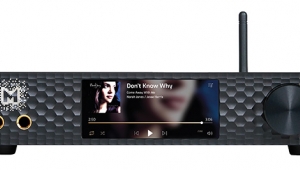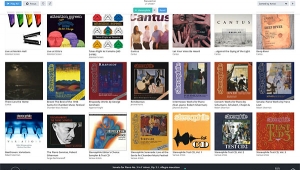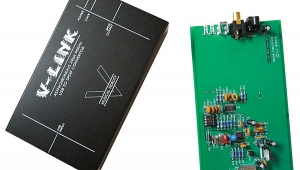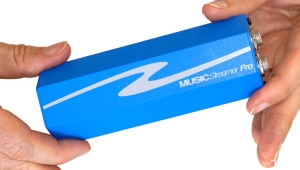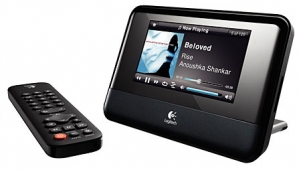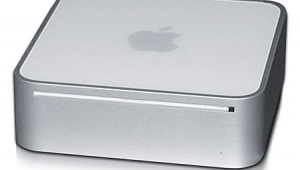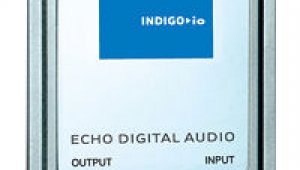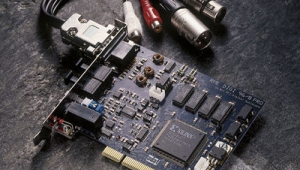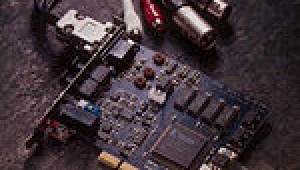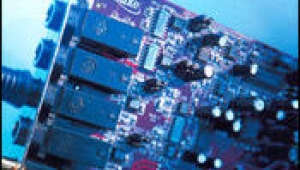| Columns Retired Columns & Blogs |
CEntrance DACport LX
John Atkinson reviewed the CEntrance DACport LX in October 2012 (Vol.35 No.10):
Footnote 1: See my review of the Sony SS-AR2 loudspeaker elsewhere in this issue for details of my current system.
When I reviewed the original CEntrance DACport USB headphone amplifier in June 2010, I was impressed by what I heard. Driving Sennheiser HD-650 headphones, the DACport's high frequencies sounded silky, with plenty of air apparent and an impressive sense of space. I had used the bus-powered DACport exclusively as a headphone amplifier, but with a suitable adapter cable, the DACport could be used to drive the power amplifier in a regular speaker-based system.
Erick Lichte wrote about using the DACport in this manner in October 2010: "The DACport sounded much the same as it did through headphones, presenting a large soundstage, a slightly rolled-off but grain-free treble, and a blossoming midrange. Through speakers, the DACport tended to slightly blend individual instruments and images together, reducing the soundstage's front-to-back layering and the delineation of each sound. However, the overall effect was always musical, and in some ways more like what a person might hear sitting farther back in a concert hall. Though not the last word in resolution, the DACport consistently put out musical, balanced sound that stood up to gear costing three to five times its modest price."

Fig.1 CEntrance DACport LX, high-resolution jitter spectrum of analog output signal, 11.025kHz at –6dBFS, sampled at 44.1kHz with LSB toggled at 229Hz, 24-bit data. Center frequency of trace, 11kHz; frequency range, ±3.5kHz (left channel blue, right red).
Since our coverage, CEntrance has introduced a less-expensive version of the DACport, the DACport LX, which dispenses with the volume control and can be used as a regular USB D/A processor. It can also be distinguished by its titanium-colored finish (the original was plain aluminum). Whereas the DACport costs $399.95, the LX is priced at $299.95. (CEntrance's Reserve Series 1m-long, ¼"-to-stereo-RCA cable adds $50 to the price of each if purchased at the same time.) Like the original, the LX operates in adaptive isochronous USB mode rather than the theoretically better asynchronous mode, but as you can see from fig.1, a narrowband spectrum of the LX's output while it reproduced 24-bit J-Test data, there are no jitter-related sidebands—not even at 1kHz, the USB sample-rate polling frequency. CEntrance uses a topology they call JitterGuard: a dual-stage clock-management system that, they claim, eliminates jitter at the D/A chip interface.

Fig.2 CEntrance DACport LX, HF intermodulation spectrum, 19+20kHz at 0dBFS peak into 300 ohms, 24-bit data (left channel blue; linear frequency scale).
Like the DACport, the LX doesn't require driver software to be installed on the host computer, and its direct-coupled, class-A output stage runs warm. (While the volume potentiometer has been replaced by a fixed-resistor divider in the LX, the headphone amplifier stage is now used as the line output amp, with the same low output impedance of 10 ohms.) The maximum output level is now 3dB lower: 2.07V rather than 3.06V. The ultimate resolution is thus reduced by the same 3dB, but the LX actually performed slightly better on the high-frequency intermodulation test (fig.2), with all spurious components below –106dB (0.0005%). (Some very low-level, power-supply–related spuriae can be seen in this graph compared with fig.11 in my review of the original. This is because, for the latter measurements, I drove the LX from a mains-powered Mac mini rather than a battery-powered laptop.)

Fig.3 CEntrance DACport LX, impulse response.
Connected with its supplied 6' USB cable and with the Reserve Series analog cables, and playing files with Pure Music, the DACport LX correctly operated with sample rates ranging from 44.1 to 96kHz, including the important 88.2kHz rate. Its impulse response (fig.3) indicated that it uses a conventional time-symmetrical, linear-phase reconstruction filter. Like the DACport, the LX's high frequencies were silky-smooth and its midrange free of grain. This couldn't do much for the first couple of tracks on our "Recording of the Month" for July 2012, Bill Evans's Live at Art D'Lugoff's Top of the Gate (Apple Lossless file, 24/44.1, HDtracks/Resonance HLP-2012), where the thin double bass and rather boxy piano continued to sound that way (footnote 1). But fed high-quality data, such as "Nowhere Man" from our December 2011 "Recording of the Month," Bill Frisell's All We Are Saying . . . (Apple Lossless ripped from CD, Savoy Jazz SVY17836), the DACport LX rose to the occasion, untangling the similar pitches of Frisell's electric guitar, Jenny Scheinman's violin, and Greg Leisz's pedal steel. Similarly, it readily resolved Tony Scherr's double bass and Kenny Wollesen's kick drum, despite reproducing both instruments with good upper-bass weight.
Some Internet writers have proclaimed the LX to sound more transparent and clear than the original DACport. Given that the only substantive difference is the replacement of the volume potentiometer with a pair of resistors, I found that hard to believe. I therefore compared the two versions, adjusting the original DACport's volume control to match the levels at 1kHz. (This was at 3 o'clock with the output jack set at 12 o'clock.) With "Ron Carter," from Bill Frisell's Blues Dream (Apple Lossless file ripped from CD, Nonesuch PRCD 300361), the descending fifths on double bass that begin the track had equally good weight and definition through both DACports. I listened again to Frisell's "Nowhere Man" with the DACport, then switched to the LX. Then back to the DACport. Then back to the LX.
Well, I'll be buggered. The LX did sound that little bit clearer. The well-recorded drums were set back a little more in the soundstage, the guitars slightly better differentiated. The lack of a volume control, of course, will be a limitation if you want to use headphones, though Pure Music's level control is a way around that problem if you use a Mac. (The iTunes volume control sounds broken in comparison.) But I have to say that the LX went that essential bit further than the original DACport—not at all what I expected to hear!
Next up was a series of comparisons with AudioQuest's new $250 DragonFly, reviewed elsewhere in this issue by Art Dudley, and with the Halide's $475 DAC HD, which I reviewed in August 2012. Levels were matched to within 0.1dB at 1kHz, and for the test track I used a mix I had done a couple of years back of a song called "New York Afterparty," from Heroes of the Open End, the band for which Stereophile's Ariel Bitran plays lead guitar. The backing features two electric guitars and synth, overlaying drums and bass. I had tried in the mix to recreate some of the phat low frequencies you hear from rock bands live—there is therefore a lot of low-frequency energy—and I had used some repeat echo on Ariel's chiming guitar patterns to place the instrument in its own space.
The DACport LX offered a clean open window into the mix, with Mike Baglivi's midrange-dominant rhythm guitar well differentiated from the other instruments. The bass guitar and kick drum were reproduced with good weight but with still enough leading-edge definition that the sound didn't become too muddy. Changing to the DragonFly, the cymbals had a little more energy apparent, as did Ariel's lead guitar; Mike Baglivi's lead vocal, which with hindsight I had mixed a little too low, usefully moved a little closer to the listener. The low frequencies still had good weight, but the bass guitar and kick drum were not quite as well differentiated as with the DACport. However, it was a close-run thing overall. I don't think I could have identified which DAC was playing without reference to the other.
The Halide DAC HD offered even better differentiation in the bass than the DACport LX, but with less weight than the DragonFly. But the Halide scored in its decoding of the spatial aspects of the recording. You could hear the church hall acoustic lit up by the snare drum a little more than with the DragonFly, and the textures of the two very different-sounding guitars were resolved more clearly. The CEntrance got close to this resolution, but with slightly less smooth-sounding highs overall.
At $299, CEntrance's DACport LX offers superb sound quality at an affordable price. Its lack of an asynchronous USB interface doesn't compromise its performance, proving that there's more than one way to skin a serial cat. And it's manufactured entirely in the US. However, it does come under competitive threat from the slightly less expensive AudioQuest DragonFly. If I had to choose, Halide's DAC HD sounds slightly smoother than either, with a better developed sense of space, though at $475 is significantly more expensive, even taking into consideration the fact that tethered cables are included in the price. But the CEntrance DACport LX is definitely a contender.—John Atkinson
Footnote 1: See my review of the Sony SS-AR2 loudspeaker elsewhere in this issue for details of my current system.
- Log in or register to post comments
